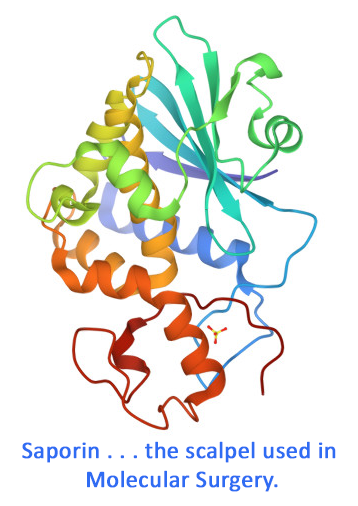Dermorphin-SAP (MOR-SAP) targets and eliminates cells expressing the mu opioid receptor (MOR). MOR-expressing neurons have long been considered some of the most important cells in the nervous systems because of their participation in pain, pain control, addiction, gastrointestinal motility, and mast cell function, among others. This specific cytotoxin provides new methods for understanding these neurons and how they work. MOR-SAP is not suitable for retrograde transport.
Dermorphin-SAP / MOR-SAP is a chemical conjugate of dermorphin and the ribosome-inactivating protein, saporin. Dermorphin-SAP eliminates cells expressing mu-opioid receptor (MOR).
Dermorphin-SAP / MOR-SAP is available individually (Cat. #IT-12) or as a kit (Cat. #KIT-12) which includes Dermorphin-SAP and Blank-SAP (Cat. #IT-21).
keywords: Dermorphin, mu opioid receptor, MOR, Dermorphin-SAP, MOR-SAP, saporin, µ-opioid receptor, addiction, pain, brain, neuroscience, peptide, neuropeptide, morphine, addiction
Inhibition of neuropathic pain by selective ablation of brainstem medullary cells expressing the µ-opioid receptor.
Porreca F, Burgess SE, Gardell LR, Vanderah TW, Malan TP Jr, Ossipov MH, Lappi DA, Lai J (2001) Inhibition of neuropathic pain by selective ablation of brainstem medullary cells expressing the µ-opioid receptor. J Neurosci 21(14):5281-5288. doi: 10.1523/JNEUROSCI.21-14-05281.2001
Summary: The presence of descending projections in the pain pathway raises the possibility that abnormal sustained activity may perpetuate chronic pain. Using 3-ng injections of dermorphin-SAP (Cat #IT-12) on either side of the RVM in rats the authors both prevented and reversed neuropathic pain caused by spinal nerve ligation.
Related Products: Dermorphin-SAP / MOR-SAP (Cat. #IT-12)
Time-dependent descending facilitation from the rostral ventromedial medulla maintains, but does not initiate, neuropathic pain.
Burgess SE, Gardell LR, Ossipov MH, Malan Jr TP, Vanderah TW, Lai J, Porreca F (2002) Time-dependent descending facilitation from the rostral ventromedial medulla maintains, but does not initiate, neuropathic pain. J Neurosci 22(12):5129-5136. doi: 10.1523/JNEUROSCI.22-12-05129.2002
Summary: Various indications, such as declining afferent discharge over time, suggest that the mechanisms involved in persistent neuropathic pain are different than those that initiate the pain. The authors have previously shown that cells expressing the mu-opioid receptor are involved in the descending pain pathway. In this work, the authors lesioned the rostral ventromedial medulla (RVM) in rats using 1.5 pmol in 0.5 µl of dermorphin-SAP (Cat. #IT-12) administered to each side of the RVM. Measurements of pain-related behavior show that mu-opioid receptor-expressing cells in the RVM are involved in the maintenance of heightened sensitivity to stimuli seen in neuropathic pain.
Related Products: Dermorphin-SAP / MOR-SAP (Cat. #IT-12)
Targeted toxins in pain.
Wiley RG, Lappi DA (2003) Targeted toxins in pain. Adv Drug Deliv Rev 55(8):1043-1054. doi: 10.1016/s0169-409x(03)00102-9
Summary: The authors discuss the use of 'molecular neurosurgery' in the study of nociception. Applications using targeted toxins, which include immunotoxins, protein-toxin conjugates, or peptide-toxin conjugates, are illustrated. The authors describe the use of these molecules as research tools, as well as their potential for therapeutics. A helpful table is included that lists neuronal surface markers and class of cells targeted for each targeted toxin. Reagents discussed: CTB-SAP (Cat. #IT-14), IB4-SAP (Cat. #IT-10), OX7-SAP (Cat. #IT-02), 192-Saporin (Cat. #IT-01), ME20.4-SAP (Cat. #IT-15), Anti-DBH-SAP (Cat. #IT-03), Anti-DAT-SAP (Cat. #IT-25), SP-SAP (Cat. #IT-07), Dermorphin-SAP (Cat. #IT-12), Orexin-SAP (Cat. #IT-20), CRF-SAP (Cat. #IT-13), and acetylated LDL-SAP (Cat. #IT-08).
Related Products: CTB-SAP (Cat. #IT-14), IB4-SAP (Cat. #IT-10), OX7-SAP (Cat. #IT-02), 192-IgG-SAP (Cat. #IT-01), ME20.4-SAP (Cat. #IT-15), Anti-DBH-SAP (Cat. #IT-03), Anti-DAT-SAP (Cat. #IT-25), SP-SAP (Cat. #IT-07), Dermorphin-SAP / MOR-SAP (Cat. #IT-12), Orexin-B-SAP (Cat. #IT-20), CRF-SAP (Cat. #IT-13), Acetylated LDL-SAP (Cat. #IT-08)
browse all references for this product | back to top


Reviews
There are no reviews yet.